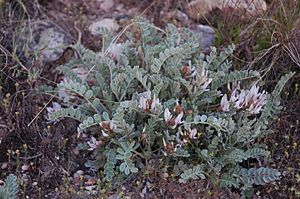Deseret milkvetch facts for kids
Quick facts for kids Deseret milkvetch |
|
|---|---|
 |
|
| Conservation status | |
| Scientific classification | |
| Genus: |
Astragalus
|
| Species: |
desereticus
|
The Deseret milkvetch (scientific name: Astragalus desereticus) is a very rare type of plant. It's a kind of milkvetch, which is a group of plants often found in dry areas. This special plant only grows in Utah County, Utah, in the United States.
For many years, people thought the Deseret milkvetch was gone forever. But in 1981, a small group of these plants was found again! Today, there are about 5,000 to 10,000 plants. They all grow in one small area, less than 300 acres big. Because it's so rare, the U.S. government lists it as a threatened species.
Contents
What the Deseret Milkvetch Looks Like
The Deseret milkvetch is a plant that lives for many years. It has a short stem that grows from a strong, woody root. This root helps the plant get water deep from the ground.
Its leaves can grow up to 12 centimeters long. Each leaf is made of several smaller parts called leaflets. These leaflets are covered in soft, silvery-white hairs. This makes the whole plant look pale.
The plant produces pretty flowers in a cluster. There are usually 5 to 10 flowers in each cluster. Each flower is about 2 centimeters long. They are a lovely pinkish-purple color, with darker tips on their petals.
After the flowers, the plant grows a fuzzy seed pod. This pod is about a centimeter long. It's a type of fruit called a legume. The Deseret milkvetch can only make new plants from its seeds. It cannot grow new plants from its roots or stems.
Where the Deseret Milkvetch Lives
This unique plant only grows in the woodlands near a place called Birdseye, Utah. This area is in Utah County, Utah. It's the only place in the world where you can find the Deseret milkvetch growing naturally.
Protecting the Deseret Milkvetch
Even though it's rare, the number of Deseret milkvetch plants has grown recently. The dangers to the plant are also not as bad as once thought. Because of this, in 2017, there was a plan to remove it from the Endangered Species List. This would mean it might not need as much special protection.
However, the plant still faces some challenges. Grazing cattle can eat the plants and damage the soil. New buildings and homes can also take away its habitat. Erosion, which is when soil washes away, can also harm the plants. Protecting its small home is very important for its future.
Gallery
See also
 In Spanish: Astragalus desereticus para niños
In Spanish: Astragalus desereticus para niños





